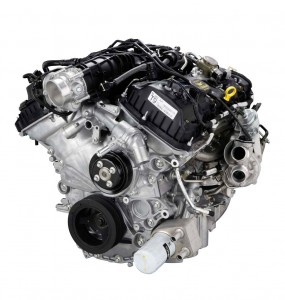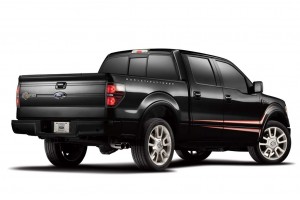
The new 3.5-liter EcoBoost V6 is expected to produce as much torque -- and deliver the same towing capacity -- as Ford's big 6.2-liter V8.
While design, creature comfort and packaging all play a role in differentiating one pickup model from another, perhaps nothing has more impact than powertrain. And for 2011, Ford Motor Co. will complete update the engine and transmission options offered for its best-selling F-Series.
For the upcoming model-year, Ford will launch four new powertrains, including a compact, high-mileage V6, a pair of V8s and the newest member of its expanding, high-tech EcoBoost line-up. Collectively, the maker claims the typical 2011 F-Series model will get about 20% better mileage than the 2010 pick-up line, despite big improvements in power, torque and towing capacity.
“Fuel economy,” explained Doug Scott, marketing manager for Ford’s Truck Group, “is building in importance with the consumer,” as much with pickups as with compact passenger cars.
Ford research shows that 70% of pickup buyers are demanding better fuel economy, and 32% say they are willing to switch brands to get higher mileage.
A major reason why Ford anticipates the big jump in 2011 F-Series fuel efficiency is the introduction of the all-new 3.7-liter V6, a four-valve DOHC package that will put out the type of numbers that only a V8 could match until recently. It will make 300 horsepower and 275 lb-ft of torque, and handle up to 6,100 trailer loads – the best in its segment according to competitive data.
At the other end of the spectrum is the new 6.2-liter V8 that Ford just yesterday announced will go into its newly-updated 2011 Harley-Davidson F-150 truck. (Click Here for more.) A hefty SOHC design, this is “more of a traditional truck engine,” according to Mike Harrison, Ford’s V8 engine manager.
Turning out 411 hp and 434 lb-ft, the 6.2-liter engine will also be offered as standard equipment in the high-style 2011 Ford SVT Raptor, and as an option in other F-150 models. It also delivers segment-leading towing capacity of 11,300 pounds, according to Harrison.

The 2011 Ford Harley-Davidson F-150 will feature the biggest engine in the new truck line-up, a 6.2-liter V8.
For those who don’t need quite that much brute force, Ford will make the 5.0-liter 4-valve DOHC V8 its primary workhorse. If that sounds familiar, no surprise, as the engine is a modified version of the new 5.0-liter going into the 2011 Ford Mustang GT.
It will be modified for truck use to improve low-end torque and towing capacity – which is rated, for the F-150, at 9,800 pounds. Among the truck tweaks, the big V8 gets retuned intake camshafts, cast iron exhaust manifolds and a lower compression ratio. It will also be E85-capable in the F-Series.
On the high-tech front, the big news is the second V6 going into the 2011 F-Series line-up. The 3.5-liter, Direct Injection EcoBoost V6 is a modified version of the engine offered in Ford’s Taurus SHO. It features twin turbos that have been modified to withstand the heavy loads and high heat that can be generated while towing a trailer of up to 11,300 pounds up a long, steep grade, according to Jim Mazuchowski, who heads the V6 program.
Ford officials declined to provide specific numbers for the F-Series EcoBoost, though a knowledgeable company source suggested horsepower will be similar to SHO’s 365 hp, while torque will be significantly better than the passenger car version’s 355 lb-ft. Expect a number closer to the 6.2-liter V8’s 434 lb-ft, the source noted, considering both deliver the same towing capacity.
Part of the overall fuel economy improvement, Ford executives noted, will be delivered by a new 6-speed automatic transmission, which will become standard equipment on all 2011 Ford F-Series models.
Fuel economy numbers are also on hold pending a final sign-off by the EPA, Ford officials said, but should be released before the official autumn launch of the 2011 F-Series line-up. All of the new engines will be available at launch except the 3.5-liter EcoBoost, which will come online during the first quarter of 2011.

I have a van with a 3.5-liter engine, 4-spd O/D transmission. I consistently get 19 mpg around town and 24 – 26 mpg on the road, depending on hills or no hills.
Once upon a time, we needed to de-rate the EPA mileage numbers by around 15%. When the new Ford’s mileage comes out, do we still need to shave off a percentage to reach reality??? Would appreciate a comment. TKS.
Hi, JM,
The EPA has repeatedly revised its testing standards to try to bring its projection in line with real-world experience — most recently in 2008. The numbers, then, were modified most for hybrids which had been proving to be far different for most drivers than what the window sticker showed. These days, my anecdotal evidence suggests that for a typical driver the mileage numbers are more accurate than ever, though a heavy-footed owner or hyper-miler will still get significantly different results. Mileage can also vary depending upon where you drive, payload, etc., and that’s especially true for pickups and other work vehicles.
Paul A. Eisenstein
Publisher, TheDetroitBureau.com
Sadly, a small turbodiesel, an engine that Detroit refuses to produce for its light trucks due to marketing and cost limitations, would still outperform the newest gasoline direct injection ecoboost engines by a wide margin. Ford has such engines in the European market but doesn’t produce them here due to the severe costs of certifying them and of retooling. The ultimate loser is the North American consumer, as usual.
In spite of Ford’s current favorite status among US manufacturers, they too can stumble and need to be worried about bringing better product to market, and a light duty diesel would be a hot item among the thirsty truck segment.
KEEP THE GOOD NEWS COMING OUT OF DETROIT. WE CAN KEEP OUR FRIENDS UPDATED.